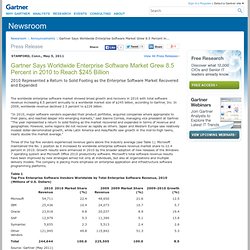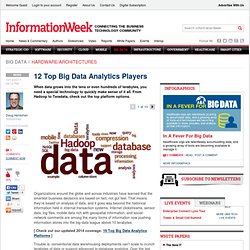

What Matters, essays about topics of global importance, curated by McKinsey & Company. Davos 2012 - Hans-Paul Bürkner. Says Worldwide Enterprise Software Market Grew 8.5 Percent in 2010 to Reach $245 Billion. STAMFORD, Conn., May 5, 2011 View All Press Releases 2010 Represented a Return to Solid Footing as the Enterprise Software Market Recovered and Expanded The worldwide enterprise software market showed broad growth and recovery in 2010 with total software revenue increasing 8.5 percent annually to a worldwide market size of $245 billion, according to Gartner, Inc.

In 2009, worldwide revenue declined 2.5 percent to $226 billion. "In 2010, major software vendors expanded their product portfolios, acquired companies where appropriate to their plans, and reached deeper into emerging markets," said Joanne Correia, managing vice president at Gartner. "The year represented a return to solid footing as the market recovered and expanded in terms of revenue and geographies. Three of the top five vendors experienced revenue gains above the industry average (see Table 1). Table 1Top Five Enterprise Software Vendors Worldwide by Total Enterprise Software Revenue, 2010 (Millions of U.S. Contacts. 12 Top Big Data Analytics Players. When data grows into the tens or even hundreds of terabytes, you need a special technology to quickly make sense of it all.

From Hadoop to Teradata, check out the top platform options. 1 of 13 Organizations around the globe and across industries have learned that the smartest business decisions are based on fact, not gut feel. That means they're based on analysis of data, and it goes way beyond the historical information held in internal transaction systems. Internet clickstreams, sensor data, log files, mobile data rich with geospatial information, and social-network comments are among the many forms of information now pushing information stores into the big-data league above 10 terabytes. [ Check out our updated 2014 coverage: 16 Top Big Data Analytics Platforms ] Trouble is, conventional data warehousing deployments can't scale to crunch terabytes of data or support advanced in-database analytics.
More Insights. Virtualization Tops CIO Priorities In 2012: IDC - Storage - Virtualization. Savings from server consolidation will go to new IT innovations, IDC says. 12 Top Big Data Analytics Players (click image for larger view and for slideshow) Virtualization and the server consolidation that it delivers will be the top priority for chief information officers in 2012, according to a survey by the research firm IDC. Savings from server consolidation will be invested in new IT initiatives such as cloud computing, mobility, data analytics, and use of social media for business purposes.
When CIOs were asked by IDC to name their top three IT priorities for this year, nearly 40 percent of them picked virtualization and server consolidation, more than any other area of IT. While IDC ranks CIO priorities, another research firm, Gartner, scaled back its IT spending increase forecast for 2012 to 3.7% growth, down from an earlier forecast of 4.6%. "We think that CIOs are well prepared for this moment. More Insights. Does Your Company Get Social Business?
Big data: The next frontier for innovation, competition, and productivity. The amount of data in our world has been exploding, and analyzing large data sets—so-called big data—will become a key basis of competition, underpinning new waves of productivity growth, innovation, and consumer surplus, according to research by MGI and McKinsey's Business Technology Office.

Leaders in every sector will have to grapple with the implications of big data, not just a few data-oriented managers. The increasing volume and detail of information captured by enterprises, the rise of multimedia, social media, and the Internet of Things will fuel exponential growth in data for the foreseeable future.
MGI studied big data in five domains—healthcare in the United States, the public sector in Europe, retail in the United States, and manufacturing and personal-location data globally. Big data can generate value in each. For example, a retailer using big data to the full could increase its operating margin by more than 60 percent. 1. 2. Podcast 3. 4. 5. 6. Publications Library.
Event_Marketing Videos. Disclosure_Management. White_Papers.